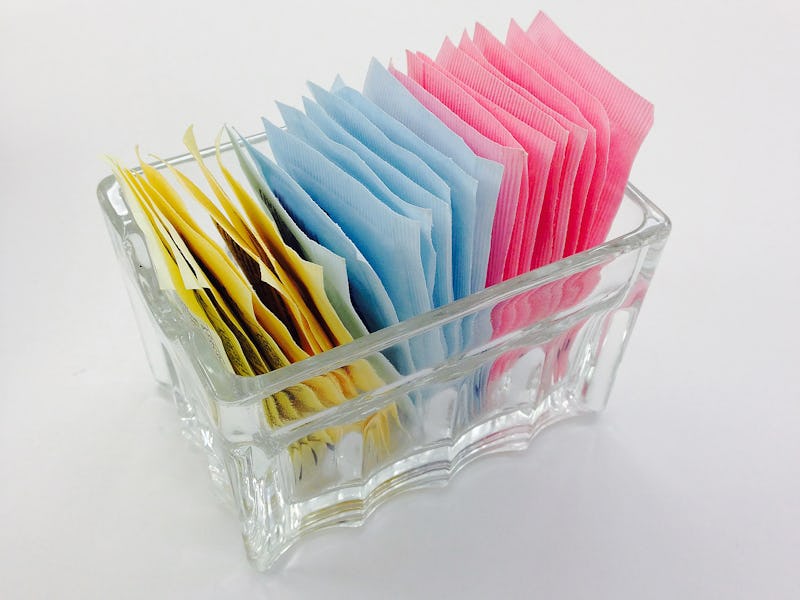Artificial sweeteners cause cancer in mice. Here's worrying data from humans.
Past studies showed a link for lab mice. This one uses data from 102,865 people.

Since the 1940s, studies have linked the wide use of artificial sweeteners to cancer in lab mice. In the 1970s, this led the U.S. to put cigarette package-like warning labels on anything containing saccharin. But in recent decades, scientists have mostly written off mice studies as inconclusive. Research on rodents cannot say anything definitive about to the risk for people.
Now a new study, published Thursday in PLOS Medicine, presents some troubling data from humans.
What’s New — Researchers combed through more than a decade of health data from 102,865 French volunteers. They found that consumption of artificial sweeteners was associated with an increased risk of cancer. Specifically, the researchers found that those who consumed any kind of artificial sweetener had a 13-to-14 percent higher probability of developing cancer than those who did not.
Artificial sweeteners are chemical creations that have almost no calories, making them seem like a healthy alternative to sugar.
The researchers looked at three common sweeteners individually: aspartame, acesulfame potassium, and sucralose. Acesulfame potassium is sold in the U.S. under the brand names Sunett and Sweet One. Aspartame is sold as NutraSweet or Equal. Sucralose you may know as Splenda.
- Cancer rates were 15 percent greater for higher consumers of aspartame and 12 percent greater for lower consumers. More than the others, aspartame intake was associated with an increased risk of breast cancer, with a 22-percent greater chance for higher consumers.
- Cancer rates were 13 percent greater for higher consumers of acesulfame potassium and 12 percent for lower consumers.
- Sucralose seemed to have the least association with cancer: Rates were not greater for higher consumers and 3 percent greater for low consumers.
Because artificial sweeteners differ vastly in how much of each is needed for desired sweetness, researchers calculated individual measurements of high and low for each one.
As is common in such studies, all these numbers were the result of adjustments to account for some factors relevant to cancer risk, including age, gender, and tobacco use, to make them more representative to the entire French population.
How They Did It — The researchers used data from the NutriNet-Santé study for which more than 170,000 French citizens have agreed to submit information about their habits and health outcomes for decades for researchers to mine for correlations. The study started in 2009. The researchers looked at data from then until January of 2021.
Every six months, volunteers get an alert to keep a diet diary, recording all foods and beverages they consumed that day, even taking photographs and keeping containers to establish serving sizes. Because of this, researchers got a decent record of which artificial sweeteners a person consumed on an average day and how much.
Why It Matters — Artificial sweeteners — also called sugar substitutes, non-nutritive sweeteners, and high-intensity sweeteners — are chemical creations that have almost no calories, making them seem like a healthy alternative to sugar. (The whole idea of diet soda was replacing the natural sugar that was once used in Coca-Cola with a no-calorie replacement.)
The FDA currently allows six artificial sweeteners in the U.S. and they are in wide usage in processed foods:
- Saccharin was discovered in 1879 and is still found in fruit juices, candies, jams, jellies, and cookies, particularly those with a “low fat” label.
- Aspartame was approved by the FDA in 1981 and often added to sodas, energy drinks, desserts, candy, chewing gum, and weight control products.
- Acesulfame potassium, approved in 1988, is used in sodas and protein shakes and added to medicines to make them more pleasant to taste.
- Sucralose was approved in 1998 and used for many of the same purposes as aspartame.
- Neotame and advantame, approved in 2002 and 2014, respectively, and not commonly used yet.
The first four are also allowed in the European Union.
Almost as soon as Johns Hopkins University chemists discovered saccharin, debate raged about the safety of artificial sweeteners.
A product of the 80s fitness craze, diet soda replaced sugar with artificial sweeteners to create a low-calorie soda.
After the Pure Food and Drug Act was passed in 1906, amid fears about the “adulteration” of food, the newly created Food and Drug Administration considered banning saccharin altogether. President Theodore Roosevelt, who was on a sugar-free diet, intervened and even called his public health advisor “an idiot” over the issue.
Studies showing that saccharin caused bladder cancer in mice led to its labeling in the U.S., banning in Canada, and a worldwide decline in its use. Starting in 1978, every packet of Sweet ’N Low and countless cans of diet soda cautioned that they contained a product that caused cancer in lab animals.
Scientists came to see this reasoning as flawed, even panicked; the mechanism by which saccharin caused cancer in mice did not apply to humans and one would have to drink hundreds of twelve-ounce saccharin-infused diet sodas daily to reach the doses fed to lab mice. The U.S. removed warning labels in 2000 and Canada reversed its ban in 2011.
After all this, many are now confused if they are “better” than sugar.
The researchers say that this is the first study to evaluate artificial sweeteners directly and not soda as a proxy. Research like this could settle the debate over artificial sweeteners, but will probably first reignite it.